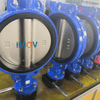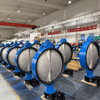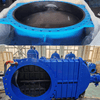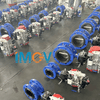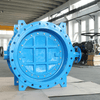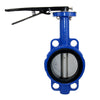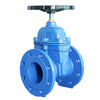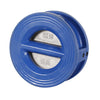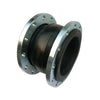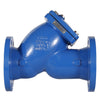Choosing the Right Butterfly Valve for Seawater Desalination
As global industrialization continues to advance, freshwater resources are becoming increasingly scarce, and water shortages have emerged as a major constraint on industrial development worldwide. As a result, seawater desalination has gradually become an important solution for coastal cities to address this challenge.
In seawater desalination plants, butterfly valves play a critical role in process control thanks to their quick operation, low torque requirements, minimal flow resistance, and versatile design options. However, due to the unique characteristics of the seawater environment, selecting the right type of butterfly valve is particularly crucial. This article focuses on the key selection considerations for butterfly valves used in desalination facilities.
The Unique Challenges of Seawater Desalination Environments
Unlike standard water supply and drainage systems, seawater desalination plants handle media with high chloride ion concentrations, which pose strong corrosive effects on metal materials. This corrosion risk is further intensified under conditions of elevated temperatures, suspended solids, or the presence of chemical cleaning agents.
Additionally, some pipelines in these systems undergo frequent operation or require valves to remain fully open or closed for extended periods, placing higher demands on the sealing performance and structural strength of the valves.
Given seawater’s aggressive corrosive nature and the need for continuous, stable plant operation, corrosion resistance becomes one of the primary factors to consider when selecting valves for seawater desalination applications.
Core Material Selection
(1) Valve Body Materials
When it comes to corrosion resistance, conventional materials such as cast iron or carbon steel are generally unsuitable for seawater applications. Recommended materials include the following:
Stainless Steel 316 (CF8M)
This material offers a balanced combination of cost-effectiveness and stable performance, making it suitable for most seawater desalination applications under ambient temperature and pressure. However, it’s important to note that in high-temperature or high-salinity environments, 316 stainless steel can still be susceptible to pitting or crevice corrosion. Therefore, its reliability should always be evaluated against the specific operating conditions.
Duplex Stainless Steel (2205, 2507)
Known for its high strength and exceptional resistance to chloride-induced corrosion, duplex stainless steel is particularly well-suited for high-risk sections such as the high-pressure reverse osmosis stage or brine recirculation systems. While the cost is somewhat higher, its excellent long-term stability and durability make it a preferred choice for critical points in seawater systems, offering an ideal balance between performance and lifespan.
Copper-Nickel Alloys (90/10 or 70/30 Cu-Ni)
These alloys provide outstanding resistance to seawater corrosion and are especially suitable for long-term use in natural seawater environments. An additional advantage is their low susceptibility to marine biofouling, which helps reduce the risk of clogging in pipelines and valves. Although copper-nickel alloys come at a relatively high price, the level of operational security they offer in critical or harsh environments is often well worth the investment.
Coated Carbon Steel (Epoxy, PTFE Coatings, etc.)
Coated carbon steel can serve as a cost-effective alternative. Common coatings include epoxy, which is suitable for neutral or mildly alkaline seawater, and PTFE, which performs better in environments containing chemical cleaning agents or more aggressive corrosive media. It is essential, however, to ensure the integrity of the coating, as any damage can compromise the system’s corrosion resistance.
(2) Disc Materials
The disc is the component in direct contact with the fluid, making its material selection critical for ensuring both erosion and corrosion resistance. Recommended options include nylon-coated discs, stainless steel, Hastelloy, or corrosion-resistant alloy materials with specialized coatings, all of which help enhance durability under harsh seawater conditions.
(3) Seal Materials
Seal materials must withstand seawater corrosion and resist aging over time. Commonly recommended options are:
EPDM (marine-grade)
Widely used in seawater desalination projects, marine-grade EPDM is particularly suitable for ambient temperature and pressure water treatment applications. It offers a cost-effective sealing solution compared to more premium materials.
PTFE
Renowned for its exceptional chemical stability, PTFE is virtually inert to most media, making it especially suitable for sections exposed to chemical cleaning processes.
FKM (such as Viton®)
Designed for higher temperature and chemically complex environments, FKM seals, while more expensive, deliver long-lasting and reliable sealing performance—particularly valuable in high-risk or frequently operated pipelines.

Structure Selection Recommendations
(1) Centerline vs Eccentric Butterfly Valve
For ordinary water treatment section, centerline soft seal butterfly valve can be used, which is economical and practical;
However, For high-pressure section, frequent opening and closing, or the need for higher sealing performance of the workstation, it is recommended to use double or triple eccentric butterfly valves, with better pressure resistance and sealing stability, especially suitable for back-pressure or high-pressure flushing pipe section.
(2) Connection Types: Wafer vs Lugged
- Wafer Butterfly valves are more space-saving and lightweight, suitable for systems with limited installation space;
- Lug butterfly valves support unilateral disassembly and assembly, suitable for areas with frequent pipeline maintenance, and the overall structure is more solid, but the cost is slightly higher.
Driving Mode and Control Requirements
Manual drive is suitable for small diameter or infrequent operation of pipeline;
Electric or pneumatic actuator is suitable for automation control system, need to pay attention to the material of the actuator (whether anticorrosive), the protection level (IP67 or above is recommended), as well as whether there is a feedback signal interface;
Note: When using the actuator near the sea or in a humid environment, the actuator should be designed with a waterproof and salt spray-proof housing to avoid the failure of the electronic control.

Other Precautions
Avoid galvanic corrosion: when different metal materials are used together, it is recommended to install insulating gaskets or adopt cathodic protection.
Impact of system cleaning: seawater desalination systems are usually equipped with CIP cleaning section, so it is necessary to confirm that the sealing materials are resistant to acid and alkali cleaning agents.
Correct installation direction: some butterfly valves still have recommended flow direction (especially soft sealing structure), so it is necessary to check the marking or the technical documents before installation.
Conclusion
In the desalination system, butterfly valves should not only meet the basic functions, but also be durable. Through reasonable material selection, structure optimization and matching of driving mode, butterfly valves can well perform the control tasks of water inlet, produced water section, concentrated water discharge and cleaning system.
In-depth understanding of the impact of different structures and materials on the life and operational stability of the valve is the key to realizing low-maintenance, high-reliability system design.
As a manufacturer specializing in high-quality butterfly valve solutions, Union Valve deeply understands the influence of different structural forms and materials on the life and system stability of butterfly valves, and is committed to providing customers around the world with low-maintenance, high-reliability products to help desalination projects operate safely and efficiently.
If you have any other questions, please contact us.

